2-4
Operating Rules
Configuring PoE/PoE+ Power Using the CLI
Configuring PoE/PoE+ Power Using
the CLI
Allocating PoE Power by Class or User-defined
Power Level
The 2910al, 3500, 3500yl and the 5400zl/8200zl switches provide maximum
flexibility by allowing the switch to detect and display 802.3af or 802.3at device
class, but does not enforce the power level specified in each device class. In
addition to this, the switch can allocate PoE/PoE+ power according to the
power level specified in each device class or a level defined by the customer.
There are three methods to allocate PoE power:
■ By device usage (default). The switch does not enforce the power limit.
■ By power level specified in 802.3af or 802.3at. The device class will be
detected according to the specification and power limits will be enforced.
■ By user-defined. Configurable per port values or a range of ports to power
level 1-17 watts or 1-33 watts for the 2910al and 3500yl-PoE+ Switches.
Incorrectly setting the PoE maximum value to be less than the device
requires will result in a PoE fault.
For more information, see the Management and Configuration Guide on the
ProCurve Web site at:
www.hp.com/go/procurve/manuals
Switch Port Priority
Using a port-number priority method, a lower-numbered port has priority
over a higher-numbered port within the same configured priority class, for
example, port A1 has priority over port A5 if both are configured with High
priority.
A port can be assigned a power priority that alters the assignment of power
to it by the switch. For more information, see the Management and
Configuration Guide on the ProCurve Web site at:
www.hp.com/go/procurve/manuals
